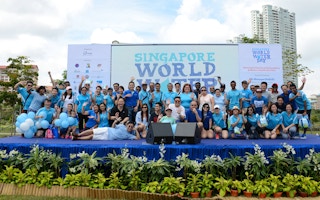As I do every year, I visited Singapore in March to participate in the country’s 2016 World Water Day festivities. Speaking with people to learn more about Singapore’s comprehensive efforts to conserve water, I was reminded of Pratt & Whitney’s own water management initiatives at our Singapore operations and how they have allowed us to reduce potable water consumption on the island by 15 million gallons since 2010.
To continue reading, subscribe to Eco‑Business.
There's something for everyone. We offer a range of subscription plans.
- Access our stories and receive our Insights Weekly newsletter with the free EB Member plan.
- Unlock unlimited access to our content and archive with EB Circle.
- Publish your content with EB Premium.
In recognition of World Water Day, and the upcoming observance of Earth Day on April 22, I would like to share about how we have achieved such significant water savings with our simple reduce, reuse and recycle approach.
Managing water flow to reduce consumption
Installing low-flow faucets and fixtures can greatly reduce the amount of fresh water that flows through faucets. They are inexpensive and easy to install, and make an immediate impact in reducing water consumption. At Pratt & Whitney, we have installed low-flow fixtures in washrooms and cafeterias at each of our facilities in Singapore.
Additionally, a water balance – a tool that compares the amount of water that flows in and out of a system – is invaluable in mitigating water leakages and identifying areas that are suitable for water reduction. At Pratt & Whitney, we use water balancing and leak management to help identify and resolve potential leaks, which can be costly if not addressed immediately.
Recirculating and repurposing water for processes
It is important to us to do everything we can to make our water supply go as far as possible. Cooling towers use significant amounts of water to remove heat and cool equipment, and we have implemented an approach to evaluate and improve the cooling tower efficiency. By properly managing and recirculating cooling tower water, this vastly reduces the volume of water and cooling tower treatment chemicals needed for processes.
Closed looping is another process that allows water re-use. Through closed looping, water treatment equipment removes contaminants from wastewater so the water can be recirculated through the same or different process. We employ closed looping at four of our facilities in Singapore. In fact, we have invested $2 million to install vacuum distillation to remove impurities from wastewater, helping to reduce the fresh water needed by our facilities in Singapore.
Using reclaimed or alternative sources of water
In a water scarce region like Singapore, every drop of water is crucial. That’s why we’ve also explored the use of alternative water sources, such as NEWater – treated wastewater in Singapore – and rainwater. At Pratt & Whitney, we aim to play our part in ensuring the country has a stable, sustainable water supply by connecting our factories in Singapore to NEWater where available. Five of our facilities here have already adopted NEWater and we hope to eventually connect our remaining facilities very soon.
Pratt & Whitney’s water management practices in Singapore have contributed significantly to the company achieving its 2015 Sustainability Goals. From a 2006 baseline, Pratt & Whitney reduced water consumption by about 54 per cent from 922 million gallons to 423 million gallons – that is enough water to fill 755 Olympic-sized swimming pools.
But our conservation efforts do not end there.
Today we are working toward Pratt & Whitney’s 2025 Sustainability Goals. When Pratt & Whitney reaches its 100th anniversary in 2025, our goal is to have reduced water consumption by 80 per cent from 2000. We are well on our way to achieving that goal today. To date, we have reduced water consumption by 72 per cent – saving one billion gallons of water across all of our manufacturing operations. That is enough to fill 1,500 Olympic-sized swimming pools.
I am proud of the many ways our employees in Singapore and around the world are helping Pratt & Whitney achieve its sustainability objectives. However, sustainability is a journey, and we will continue searching for more ways to reduce our impact on the environment.
By sharing Pratt & Whitney’s water management practices, I hope other companies will be encouraged to learn more about how water management practices can make a huge difference in protecting the world’s water supply.
Mary Anne Cannon is vice pesident of environment, health & safety, Pratt and Whitney. This post was written exclusively for Eco-Business.











